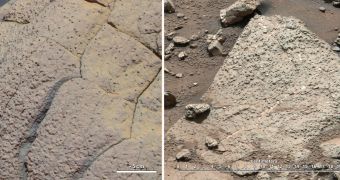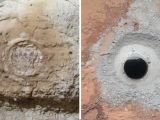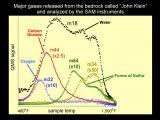NASA's Curiosity rover has found conditions very favorable to life on Mars, its analysis of rock samples led it to discover that, when the planet was wet, at least at its location, the conditions were perfect for bacterial life.
Curiosity's internal laboratory found sulfur, nitrogen, hydrogen, oxygen, phosphorus and carbon in the sample, all critical for life to develop and survive.
This is the first time scientists have been able to say without a doubt that Mars was once capable of harboring life.
This is also the first environment outside of planet Earth that we know could have sustained life.
From the chemical makeup of the sample, scientists determined that Curiosity's current location, Yellowknife Bay, was near the end of a river system or the bed of a lake that dried up periodically.
The clay and sulfate minerals were created in wet conditions and, what's more, indicate that the environment was not oxidizing, acidic or very salty. Most likely it had a neutral PH or was slightly alkaline.
In fact, scientists believe the water was so clean, any human on Mars at that time would have been able to drink it.
Not only was the environment not harmful to life, it would have been able to sustain it, the various elements had different states of oxidation ranging from oxidized, partially oxidized to non-oxidized.
Bacteria on Earth can use this as an energy source, treating the material as a battery.
Scientists had already been aware of the partial oxidation of some of the material when they saw that the rock was made up of grey dust rather than red one like on the surface.
To be clear, Curiosity found no actual signs of life. These are the results of analysis with the CheMin instrument which, as its name suggests, is designed to analyze minerals, not organic material.
But life like the one on Earth would have found perfect conditions on Mars.
Curiosity did in fact find some organic material with its SAM laboratory, but the team can't rule out contaminants just yet, so further analysis is needed.
SAM found some simple chlorinated organics but no complex organic molecules. It did find CO2, which is probably the biggest discovery.
Curiosity can't actually detect life, it can only find signs that life existed in the form of various organic material which may be the result of bacterial activity.
But even this would require a lot more analysis and experiments. For now, the team will focus on taking more samples and further analysis before any major new step.
A couple of delays, first a computer glitch then high solar activity, pushed back the analysis. This was the first time a rover was able to retrieve and analyze a sample from below the surface.
Unfortunately, the team won't be able to communicate with Curiosity for much of April, due to the position of Earth relative to Mars, so any new drilling will have to wait until May.

 14 DAY TRIAL //
14 DAY TRIAL // 

